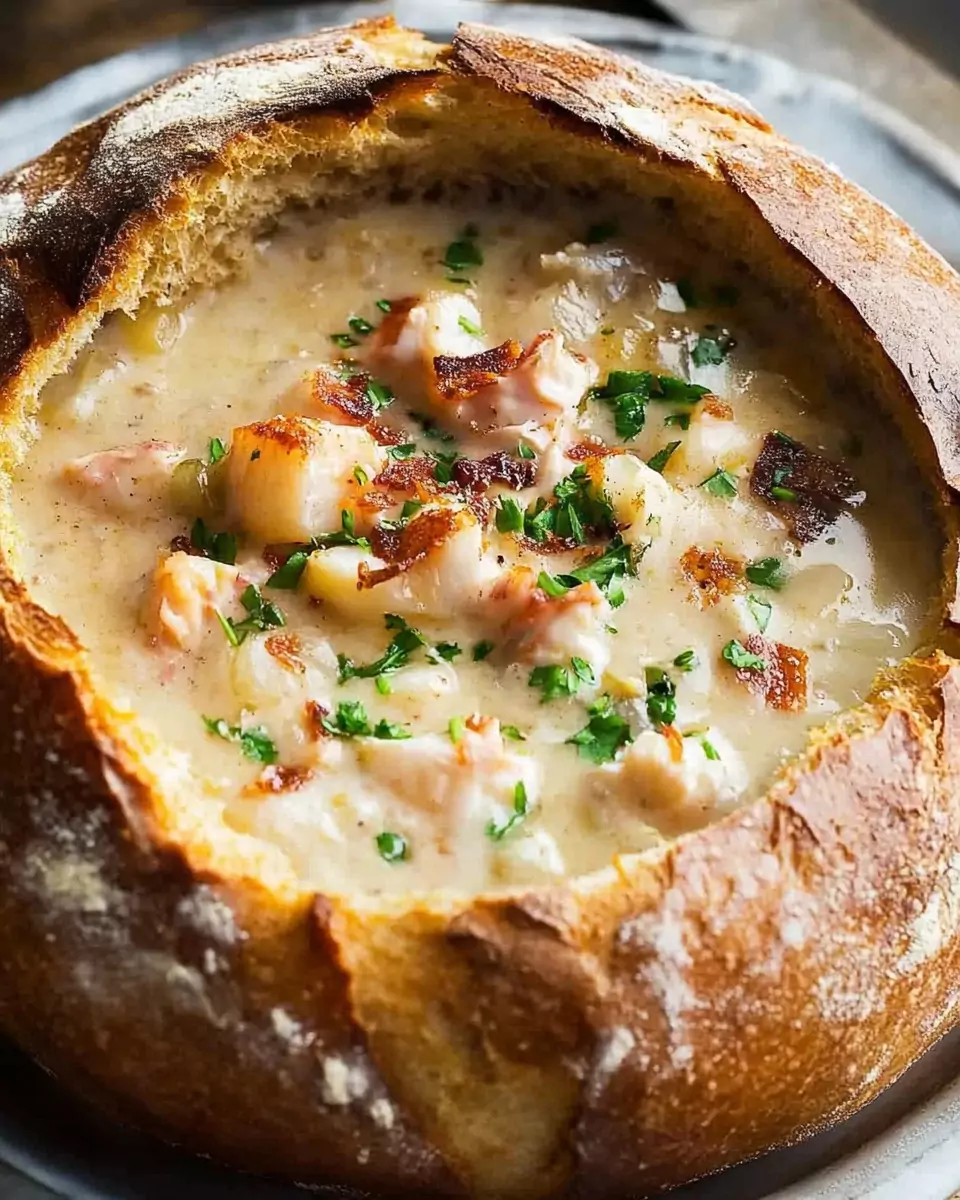The Seafood Chowder Bread Bowl is a luxurious and hearty dish that combines creamy seafood chowder with crusty sourdough bread. This recipe transforms your meal into a gourmet experience, making it perfect for dinner parties or cozy family dinners. The rich flavors of cod, salmon, and mussels come together in a velvety broth, served in an edible bread bowl that soaks up every delicious drop.

Why You’ll Love This Recipe
- Irresistible combination: Creamy chowder and crusty sourdough bread offer the perfect balance of texture and taste.
- Customizable: Use your favorite seafood or swap ingredients to suit your preference.
- Show-stopping presentation: Impress your guests with edible bread bowls that elevate the dish.
- Comfort food perfection: Warm, filling, and packed with flavor, this dish is perfect for any season.
Preparation Phase
Essential Tools and Equipment
To ensure a smooth and enjoyable cooking experience, gather these essential tools:
- Large stockpot: For boiling potatoes and simmering the chowder.
- Medium sauté pan: For cooking mussels.
- Strainer and paper towel: To filter mussel juice and remove any sand.
- Knife and cutting board: For chopping vegetables and seafood.
- Bread knife: To neatly cut the tops off bread loaves.
- Wooden spoon: For stirring and combining ingredients.
Why These Tools Matter
- A large stockpot ensures even cooking of potatoes and chowder.
- Filtering the mussel juice with a strainer and paper towel removes grit, ensuring a smooth chowder.
- A bread knife helps hollow out sourdough loaves cleanly, leaving sturdy, leak-proof bowls.
Ingredients
Seafood Base
- 1 lb mussels
- 3.5 oz fresh cod
- 3.5 oz fresh salmon
Vegetables
- 1 onion, diced
- 2 carrots, chopped
- 2 celery stalks, diced
- 2 potatoes, peeled and chopped
Dairy and Fats
- 1 ¼ cup milk
- ½ cup cream
- 2 tbsp butter
- 2 tbsp olive oil
Seasoning
- Salt and pepper to taste
- 1 bay leaf
Additional Ingredients
- 5 oz bacon
- 1 cup white wine
- 4 sourdough bread loaves
- Edible flowers for garnish (optional)
Step-by-Step Directions
1. Prepare the Mussels
- Heat 1 tbsp of olive oil in a medium sauté pan over medium heat.
- Add 1 clove of garlic, sliced thinly, and sauté until fragrant.
- Toss in the mussels, cover the pan, and cook until the mussels open, stirring occasionally.
- Pour in 1 cup of white wine and let it simmer until the liquid evaporates.
- Remove mussels and strain the liquid through a paper towel-lined strainer to remove sand. Reserve both mussels and the strained juice for later use.
2. Boil the Potatoes
- Place peeled, chopped potatoes in a large stockpot.
- Add milk, cream, and the bay leaf.
- Bring to a gentle boil over medium heat, then reduce to a simmer.
- Cook for about 20 minutes or until the potatoes are soft and tender.
3. Prepare the Chowder Base
- In a separate large pot, melt 2 tbsp butter over medium heat.
- Add diced onion, chopped carrots, and diced celery. Sauté until softened, about 5-7 minutes.
- Add bacon and cook until slightly crispy. Stir frequently to prevent sticking.
- Pour the boiled potatoes and their milk mixture into the pot with the sautéed vegetables.
- Stir in 1 cup of the reserved mussel juice. Simmer for 5 minutes to blend flavors.
4. Add Seafood
- Gently place the cod and salmon into the chowder base.
- Add the reserved mussels and stir carefully to avoid breaking the fish.
- Simmer until the fish is cooked through and flakes easily, about 5-7 minutes.
- Taste and adjust seasoning with salt and pepper as needed.
5. Prepare and Fill Bread Bowls
- Using a bread knife, cut the tops off the sourdough bread loaves.
- Hollow out the inside of each loaf, leaving a sturdy crust to hold the chowder.
- Fill each bread bowl with the hot seafood chowder.
6. Garnish and Serve
- Garnish each bread bowl with edible flowers or a sprinkle of chopped fresh parsley for an elegant touch.
- Serve immediately and enjoy the comforting flavors of the Seafood Chowder Bread Bowl!
Tips for Success
- Don’t skip the mussel juice filtering: Straining ensures your chowder is free of grit or sand.
- Hollow bread carefully: Leave a thick enough crust to prevent the chowder from leaking.
- Monitor seafood cooking times: Overcooked seafood becomes rubbery.
Serving Suggestions
Elevate your Seafood Chowder Bread Bowl with complementary sides and pairings that balance the rich, creamy flavors. Here are some ideas to complete your meal:
Drinks
- Pair with a crisp white wine like Sauvignon Blanc or Chardonnay.
- For non-alcoholic options, a refreshing cucumber and mint-infused water balances the richness.
Sides
Enhance the meal with these delicious side dishes:
1. Citrus Arugula Salad
- Toss arugula with orange slices, shaved fennel, and a citrus vinaigrette for a zesty, refreshing side.
2. Garlic Roasted Asparagus
- Roast asparagus with olive oil, minced garlic, and a sprinkle of parmesan. Its earthy flavor complements the seafood.
3. Cheesy Garlic Breadsticks
- Serve breadsticks brushed with garlic butter and topped with melted mozzarella for extra indulgence.
4. Classic Caesar Salad
- A Caesar salad with crunchy croutons and tangy dressing provides a nice contrast to the creamy chowder.
5. Oven-Roasted Brussels Sprouts
- Roast Brussels sprouts with balsamic glaze and crispy bacon for a savory, caramelized side.
6. Sweet Cornbread Muffins
- Add a hint of sweetness to the meal with moist, buttery cornbread muffins.
7. Pickled Vegetables
- A small plate of tangy, pickled vegetables like cucumbers, onions, or radishes helps cleanse the palate.
8. Homemade Potato Chips
- Crunchy, lightly salted potato chips are a delightful snack to enjoy alongside the chowder.
Common Mistakes to Avoid
Even a straightforward recipe like the Seafood Chowder Bread Bowl can have some pitfalls. Here’s how to avoid them:
1. Overcooking Seafood
- Problem: Seafood can become rubbery if cooked too long.
- Solution: Add the seafood towards the end of cooking and monitor it closely. Remove from heat as soon as it’s opaque and flaky.
2. Using Unfiltered Mussel Juice
- Problem: Sand or grit can ruin the chowder’s texture.
- Solution: Always strain the mussel juice through a paper towel or fine mesh strainer.
3. Hollowing Bread Loaves Too Thin
- Problem: The bread bowl may collapse or leak if not sturdy enough.
- Solution: Leave a thick crust when hollowing out the sourdough loaves.
4. Rushing the Vegetables
- Problem: Undercooked vegetables can be unpleasantly crunchy.
- Solution: Sauté vegetables until tender before adding them to the chowder base.
5. Skipping the Garnish
- Problem: A lack of garnish can make the presentation feel incomplete.
- Solution: Add edible flowers, fresh parsley, or even a sprinkle of paprika for color and visual appeal.
Recipe Tips for Perfect Results
Follow these pro tips to ensure your Seafood Chowder Bread Bowl turns out flawlessly every time:
Choose Fresh Ingredients
- Seafood: Use the freshest cod, salmon, and mussels available for the best flavor. Frozen options work if thawed and dried thoroughly.
- Bread: Opt for sturdy sourdough loaves that can hold the chowder without collapsing.
Enhance Flavors
- Add a pinch of smoked paprika or a splash of hot sauce for a subtle kick.
- Use fresh herbs like thyme or dill in the chowder base for an aromatic twist.
Presentation Matters
- Hollow the bread bowls just before serving to keep them fresh and crisp.
- Garnish with colorful edible flowers or finely chopped chives for an elegant touch.
Adjust for Dietary Preferences
- Substitute heavy cream with coconut milk for a dairy-free option.
- Use gluten-free bread or serve in a bowl for a gluten-free version.
Storage and Reheating Instructions
Storing Leftovers
- Chowder: Transfer leftover chowder to an airtight container and refrigerate for up to 2 days.
- Bread Bowls: Store separately in a resealable plastic bag at room temperature for up to 1 day.
Freezing Tips
- Avoid freezing the chowder with potatoes, as they may become grainy. Instead, freeze the seafood and broth mixture separately for up to 2 months.
Reheating Instructions
- Reheat chowder gently in a pot over low heat, stirring occasionally to prevent the cream from separating.
- If reheating in a microwave, use short bursts on medium power and stir between intervals.
FAQs
Can I use other types of seafood?
Absolutely! Feel free to include shrimp, scallops, or clams in your chowder. Just adjust the cooking time based on the seafood’s size and texture.
What’s the best way to prevent soggy bread bowls?
To avoid sogginess, hollow the bread just before serving, and fill it with hot chowder immediately before eating.
Can I make the chowder ahead of time?
Yes, you can prepare the chowder a day in advance. Store it in the refrigerator and reheat it before filling the bread bowls.
How can I thicken the chowder if needed?
If the chowder is too thin, mix 1 tbsp of cornstarch with 2 tbsp of cold water and stir it into the chowder. Simmer for a few minutes until thickened.
What can I use instead of sourdough bread?
French bread or a hearty artisan loaf can substitute for sourdough.
Can I make this recipe vegetarian?
Yes, replace the seafood with mushrooms, corn, and other hearty vegetables. Use vegetable broth instead of mussel juice.
Conclusion
The Seafood Chowder Bread Bowl is more than a meal—it’s a warm, comforting experience that brings a touch of elegance to your table. With its rich, creamy flavors and unique presentation, this dish is perfect for impressing guests or indulging in a gourmet treat at home.



Leave a Comment